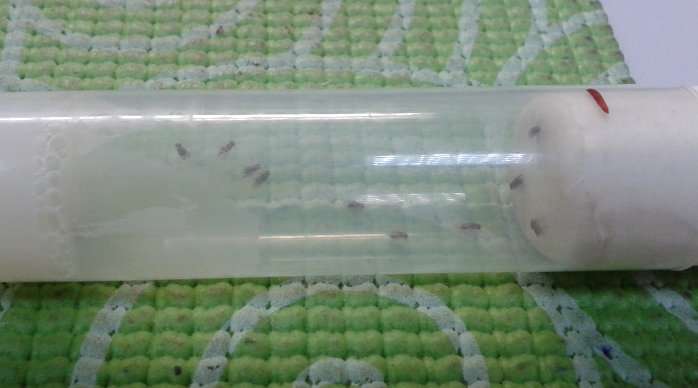Weak doses of radiation prolong life of female flies, scientists find

Scientists at MIPT have revealed that weak doses of gamma radiation prolong the life of drosophila flies (fruit flies), and that the effect is stronger in females than in males. These findings could reveal the genes that enable the prolongation of life and in the future lead to the means of preventing aging in humans. The results of their study were published in the prestigious scientific journal PLOS ONE.
A group of scientists has studied the mechanism of radiation hormesis, the effect by which moderate stress has a stimulating effect on an organism and enables the prolongation of life. This effect was first observed at the end of the 19th century by the German pharmacologist Hugo Shulz, who discovered that small doses of poison speed up the growth of yeast cells. The effect was later discovered in many other organisms, in particular in peppermint and roundworms.
"Small doses of poison or the moderate influence of other stress factors affect the organism in such a way that the stimulation effect overcomes the harm. This can lead to an increase in life expectancy," explains Svetlana Zhikrivetskaya, lead author of the article.
In recent years, scientists have been actively studying the influence of radiation hormesis, observing beneficial effects of weak doses of ionizing radiation. It is a commonly accepted view that there can be no safe doses of radiation, as any radiation will damage DNA at a molecular level. An acceptable dosage is considered to be that at which the risk of cancer is negligibly small.
However, a number of experiments have demonstrated an improvement under radiation of indicators of life expectancy in mice and cell cultures. Indirect confirmation of radiation hormesis can be seen in cases of accidental irradiation of large groups of people over extended periods of time.
For instance, in 1982 in Taiwan, 20 tonnes of steel were accidentally contaminated during smelting with cobalt-60. This steel was then used as construction material and, for about 20 years, around 10,000 people were subjected to the effects of irradiation at a level of approximately one thousand times that of the natural background. Scientists who have investigated these people reached the conclusion that the number of cases of cancer in this group of unwilling experimental subjects is lower than normal. This conclusion has, however, been criticized, and the very idea of radiation hormesis has remained controversial.
Moskalev's group has researched the effect of low radiation doses. The scientists had previously established that the radiation has a statistically significant influence on the larvae of drosophila flies, which demonstrate increased life expectancy. Moreover, they become more resilient to stress, for example, to overheating. In their new research, the group has shown that gamma radiation affects adult drosophila and via the activity of various genes changes.
"It is suggested that hormesis is universal, that its mechanism of operation through stress genes and stress paths is very similar to that of wounded animals. We are looking for these common paths and are compiling a list of the relevant genes. It is possible to do this more quickly, simply and cheaply using flies rather than mice and other animals," says Zhikrivetskaya.
The experiment has involved about 2,000 drosophila flies (1,000 males, 1,000 females) and there was a control group of 2,000 flies. The experimental group was divided into four sub-groups, each of which received their dose of radiation from a radium 266 source—about 0.05 to 0.4 grays (Gy). The amount of radiation energy absorbed by the various tissues (for example, the skin of the organism) was measured in grays. A dose of 6-8 Gy received by a person will cause acute radiation sickness within a few days; a dose of 3 Gy will act within a few weeks, and a dose of 0.05 Gy is the accepted dose limit for people whose work is connected with radiation.
By contrast with humans, adult flies bear radiation well—even a gigantic dose of 1000 grays does not lead to instantaneous death, but only to a shortening of life. Therefore, doses of tens and hundreds of grays, which could cause radiation sickness in people, do not seriously affect flies.
"The results of our experiment have demonstrated that life expectancy of the drosophila increases. Furthermore, the effect is significantly stronger in females: For females, life expectancy was extended by 7.6 percent, whilst for males it grew by just 3.4 percent. On average, a drosophila lives for about two months, but we find a significant increase of about a week," Zhikrivetskaya adds.
But the scientists are considerably more interested in which genes are active in this process and how. "If we can understand the genetic mechanisms at work here, in the future, we will be able to activate them without stress—that is, we can activate the mechanism that leads to beneficial effects from small radiation doses without the radiation itself," the researcher explains.
In their experiment with drosophila, the scientists investigated changes in the activity of 29 genes. And these changes were measured many times: immediately after radiation, after 6 hours, after 24 hours and then after 48 and 72 hours.
"We have discovered that several genes that are involved in the repair (restoration) of DNA are super-stressed for a period of 48 to 77 hours after exposure to radiation. In a number of cases, the sex of the fly affected whether genes demonstrated super-stress," says Zhikrivetskaya.
The scientists are planning future research into the phenomenon of radiation hormesis in other living organisms, mice in particular. "In the final analysis, this will allow us to find methods of extending human life expectancy," concludes the researcher.
More information: Zhikrevetskaya S, Peregudova D, Danilov A, Plyusnina E, Krasnov G, Dmitriev A, et al. (2015) Effect of Low Doses (5-40 cGy) of Gamma-irradiation on Lifespan and Stress-related Genes Expression Profile in Drosophila melanogaster. PLoS ONE 10(8): e0133840. DOI: 10.1371/journal.pone.0133840

















